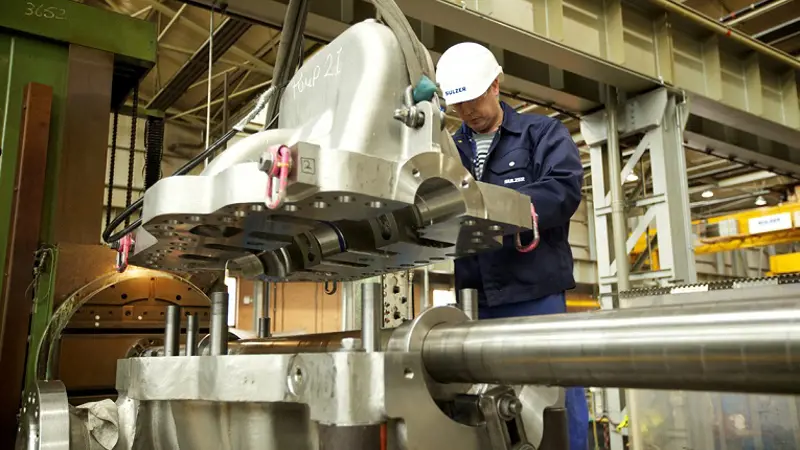When a 40-year-old refinery pump became due for overhaul it required specialist knowledge before it could be reconditioned and returned to service. Sulzer could supply just that, and the work was carried out at Sulzer’s service center in Buenos Aires.

Re-assembly of the pump before being hydro tested at 1.5 times working pressure.
The normal life cycle for a hardworking and crucial asset such as a boiler feed pump is 20 years. However, a Sulzer BB3 pump removed from a refinery in Argentina has been given a new lease of life at 40. Rejuvenating legacy equipment is a specialist field that needs considerable expertise for a successful outcome.
BB3 pumps operate throughout the oil & gas industry as well as the hydrocarbon sector. In this case, one example was running as one of a pair of boiler feed pumps in a refinery in Argentina. The pump had to be taken out of service at short notice and refurbished quickly to ensure adequate capacity for the boiler.
Minimized downtime
The spare pump continued to operate but the failed pump was sent as a critical repair to enable it to return to active duty at the earliest opportunity. This would minimize any downtime and secure the reliable service of the pump for years to come.
Sulzer regularly provides maintenance services to the refinery and was one of the first to be invited to submit a quote for the inspection and subsequent repair of the pump. Sulzer’s bid was accepted in the main because of the price and the quality that the company offers, but also because of the speed with which such repairs can be completed.
The pump, which had been in service for more than forty years, was removed and shipped to the service center in Buenos Aires. The initial inspection revealed damage to the pump body as well as corrosion of the pump case. The shaft was damaged and all the wear rings would also need to be replaced.
The pump shaft was removed and inspected in-house using non-destructive testing (NDT) procedures and found to be damaged beyond repair, so it was also replaced. These tests are crucial in detecting structural flaws and in this case, tests were conducted on all of the pump components.
Once the full extent of the required repair had been established, the casing walls were rebuilt using a welding process that adds a layer of material that can be machined back to specifications. With the welding complete, this section was again inspected using NDT before the casing was transferred to the machine shop where it could be re-bored.
Comprehensive testing
In the meantime, the new pump rotor was reassembled and balanced, while the wear rings were replaced when the casing repairs had been finished. The pump was put back together before being hydro tested at 1.5 times working pressure. The test procedure was designed and performed by Sulzer’s engineers to ensure that pump was ready to be reinstalled.
Throughout the repair project, constant contact with the customer was maintained explaining the findings and the proposed resolutions. The customer was happy with the quality of the work completed and the attention to detail that ensured a robust repair.
Esteban Obiglio, sales manager, at Sulzer explains: “It is essential in any overhaul project to deliver the best possible solution and ensure the customer is kept up-to-date. It is also important to understand the expectations of your customer and make every effort to deliver a cost-effective and reliable repair.”
Future plans
Throughout the project, the customer frequently visited the service center to review progress and discuss options for the pump that remained in service, which was a similar age and therefore facing comparable issues with erosion and wear. One potential solution, suggested by the customer, was to replace the casing, a project that could be completed in approximately two weeks.
Esteban concludes: “The customer was looking to the future and by discussing possible solutions, was able to assess all the options and make an informed decision. The refurbished asset will provide cost-effective and reliable service for many years to come.”



